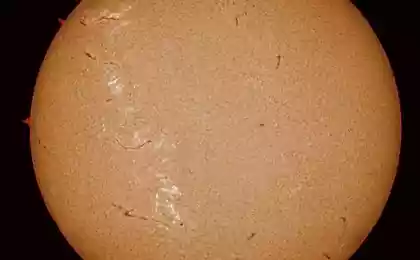1444
The winner of the "Earth and Space"
The winner of the "Earth and space»
Pale green glow of the Northern Lights occur from exposure to oxygen atoms high in the atmosphere of subatomic particles emitted by the Sun. These particles are attracted to the north and south poles of the magnetic field of the Earth, which is why such a light show so often observed in the frozen landscapes of the Arctic and Antarctic. Photographer managed to catch a thin icy color of earth, water and sky.
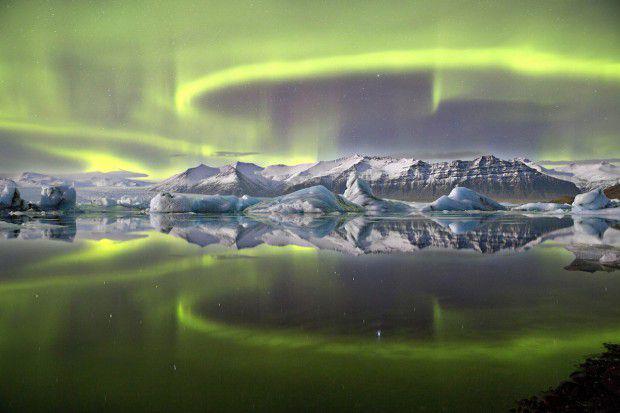
Star tracks over wind farm, Matt James, Australia
Second place in the "Earth and space»
This monochrome composition with high quality graphics. It demonstrates the power of the wind with the apparent motion of the sky: the earth's rotation turns the track motion of stars in a real downpour. One of the windmills, unlike the others, remains real. It clearly distinguishable from the rest of the blade stand out, similar to the dandelion.

Lunar Ball, Patrick Cullis, USA
This was praised by the photo was taken from a high-altitude balloon launched in Boulder, at an altitude of 26 500 meters just west of Denver, Colorado. The moon was visible only when the balloon passed through a bright haze of the atmosphere and entered the rarefied air of the stratosphere.

Venus - The Moon, Kwon Chul Oh, South Korea
Photography was praised in the "Earth and space»
Using high dynamic range (HDR) photographer counterbalance the brightness of the rising moon and Venus are much more distant, to show us what happens when they are in the same position in the sky. Venus is hidden from us our closest cosmic neighbor, but becomes visible in less than an hour. The photo shows a relatively rapid apparent motion of the Moon around the Earth, one of its orbit around the planet takes 27 3 days. This is an impressive interaction of the Moon and Venus can be seen from some places in the world several times a year, but it takes careful planning to take his picture.
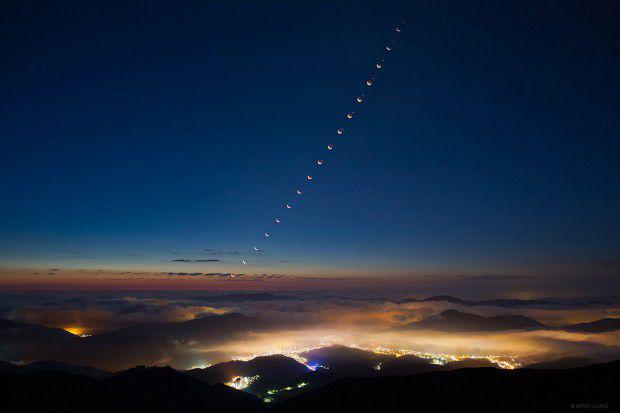
Eclipse above the clouds, Katalin baldeya, Romania
Another highly otsenёnnoe photo
The total solar eclipse - is one of the most beautiful sights of nature, it is not surprising that many people are willing to go to great lengths to see at least one. On Earth during a total eclipse, when the moon completely obscures the sun, lasts only a few minutes. But bad weather can ruin your chances of seeing it. Here you might find plane: you can fly above the clouds and chase the shadow of the moon, keep your way around the Earth.

Ripples on a pond, Alexander Hart, UK
The winner of the "Our Solar System»
Boiling surface of the Sun, located somewhere far beneath us, was captured on this unforgettable picture conveys the full extent and brutality of our parent star. The zone of solar activity on the left can be several times to swallow the whole Earth, and there still remains a place. Photographer successfully compared this phenomenon with throwing a stone into a pond: the outer layers of the Sun really behave like a fluid, which constantly twist and distort the intense magnetic forces.

Best of the craters, George Tarsodis, Greece
Second place in the "Our Solar System»
The word "crater" was put into use in the XVII-th century Italian astronomer Galileo Galilei. He brought him out of the ancient Greek term «krater», indicating a vessel for mixing wine and water. Resulting from meteorite impacts for more than a billion years, these bowl-shaped lunar depression usually named after the scientists, artists and explorers. The peak in the center of the crater, appeared likely when the crater rocks jumped up after its formation.

Eruption calcium By Stephen Ramsden, USA
High score in the "Our Solar System". The length of the solar emission is 1, 3 million km.
"Calcium K" refers to a specific wavelength violet light emitted by calcium ions in extreme conditions, such as solar atmosphere. Astronomers can get evidence of extreme events, such as the release of a huge surface of the sun, only when taking still images in a very narrow range of colors.
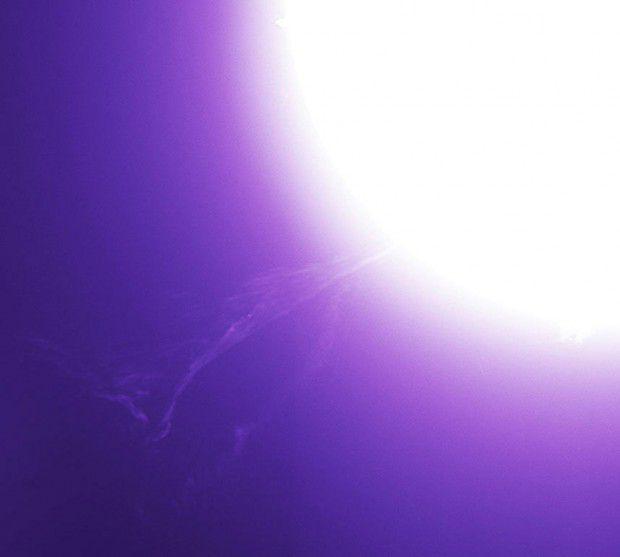
Diamond and ruby, Tunsh Tezel, Turkey
High score in the "Our Solar System»
Many features of the Sun will become visible only during a total solar eclipse, when the Moon blocks the bright solar disk. In the photo we see the sun's outer atmosphere, or corona, as a white fog. The closest to the surface layer of the atmosphere of the Sun, known as the chromosphere, appears here in the red glow of hydrogen. Photographer caught the moment when a tiny part of the solar disk is shining between the mountains on the edge of the moon, creating an effect called "diamond ring».

Horsehead Nebula, Bill Snyder, US
The winner of the "Deep Space»
Horsehead Nebula - is one of the most popular sites for filming in the night sky, but this picture presents it in a whole new light. Instead of focusing solely on the dark silhouette of the nebula itself, the photographer draws attention to the folds like a folded cloth landscape of gas and dust in its grounds funnel tends to a bright star. This image expands our vision and gives a new view of familiar celestial object.

The Helix Nebula, David Fitz-Henry, Australia
Second place in the "Deep Space»
The Helix Nebula, like a huge eye looking at us across 700 light years of space, this is one of the closest planetary nebulae to Earth, and most of them studied. In this image, a glowing gas that makes up the nebula visible small details, such as similar to tadpoles "cometary knots", which seems to be moving from the inner to the outer ring. The "head" of each such unit about the size comparable to our solar system.

California against the Pleiades, Rogelio Bernal Andreo, USA
High otsenёnka in the "Deep Space»
Pleiades on the right side of this picture, is known as the Seven Sisters, in fact, includes nearly a thousand stars that were formed about 100 million years ago. Pleiades - a perennial favorite of amateur astronomers and astrophotographers, but this unusual image shows the cluster in the broader context of its local environment, drifting through the chaotic region of dark dust. California Nebula, named in honor of the US state - is a cloud of glowing hydrogen gas in the left part of the photo.
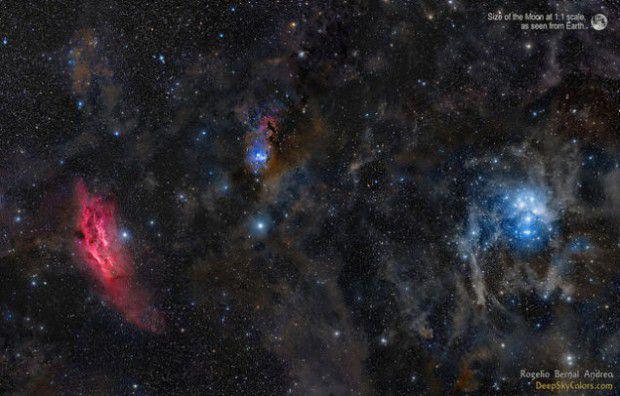
Fragment Veil Nebula, Jay-P. Metsavanio, Finland
High score in the "Deep Space»
Angular shape and bright color palette convey violent origin of this gas structure - this is what is left of the star that exploded more than 5,000 years ago. Smear is still expanding, and now occupies the entire nebula is 36 times larger in area than the full Moon.

At the feet of Orion, Marco Lorenzi, Italy
High score in the "Deep Space»
These photos remind us that our galaxy is much more likely than it seems at first glance, and that the space between the stars is rarely empty. Extremely long 18-hour exposure allows you to see billowing clouds of dust and gas, which are usually located in the shadow of its more famous neighbor to the upper part of the picture - the dazzling heart of Orion. Scattered bright blue stars illuminate the dust, which allows us to see the full picture.

Horsehead Nebula, Shishir and Shashank Dolakov - 15 years, United States
The winners of the contest "Young astrophotographer year»
This is an excellent photo Horsehead Nebula. It clearly shows the well-known red glow on the background of a horse's head - it glows, hydrogen gas, ionized neighboring stars. Image focuses on the highly concentrated cloud of dust in the silhouette of a horse's head. It is silhouetted against the red glow because Nebula blocks the path of light rays that are trying to break through it.

Coastal stairs, Chris Murphy, New Zealand
Award winner Sir Patrick Moore for the best debut
It seems that this gloomy scene seeks to convey a message of "deep time", because each layer of rocks that are in the foreground - a record of thousands of years of geological history. Meanwhile, in the sky, time and space are inextricably intertwined, as starlight take decades, centuries or even millennia to get us through the enormous gulf of space.

Hybrid solar eclipse 2, Eugene Kamenev, Germany
The winner of the "People and Space»
This is a rare example of a hybrid solar eclipse began at dawn over the western Atlantic, where the moon does not completely obscures the sun, leaving a bright ring of light around. When the Moon's shadow moved across the ocean to the east, the eclipse was complete, and the sun was not visible at all. By the time the eclipse reached Kenya, Sun once again came out from behind the moon, having a crescent shape at sunset.

NGC 3718, Mark Hanson, USA
The winner among the category of automated telescopes
Comment Photographer:
"This picture is NGC 3718 was made in a research observatory Doc Greiner, one of several remote observatories located at Rancho Hidalgo, New Mexico. Data collection lasted two full brightness overnight at excellent visibility. The program "Aladin Sky Atlas" counted on this picture more than 5000 galaxies ».
About the NGC:
"This is a barred spiral galaxy, found in the constellation Ursa Major. Gravitational interactions with its nearest neighbor, NGC 3729 (a spiral galaxy below and to the left) is likely to cause significant curvature of the spiral arms of the galaxy, while the dark band of dust enveloped her center ».

Source: www.factroom.ru
Pale green glow of the Northern Lights occur from exposure to oxygen atoms high in the atmosphere of subatomic particles emitted by the Sun. These particles are attracted to the north and south poles of the magnetic field of the Earth, which is why such a light show so often observed in the frozen landscapes of the Arctic and Antarctic. Photographer managed to catch a thin icy color of earth, water and sky.

Star tracks over wind farm, Matt James, Australia
Second place in the "Earth and space»
This monochrome composition with high quality graphics. It demonstrates the power of the wind with the apparent motion of the sky: the earth's rotation turns the track motion of stars in a real downpour. One of the windmills, unlike the others, remains real. It clearly distinguishable from the rest of the blade stand out, similar to the dandelion.

Lunar Ball, Patrick Cullis, USA
This was praised by the photo was taken from a high-altitude balloon launched in Boulder, at an altitude of 26 500 meters just west of Denver, Colorado. The moon was visible only when the balloon passed through a bright haze of the atmosphere and entered the rarefied air of the stratosphere.

Venus - The Moon, Kwon Chul Oh, South Korea
Photography was praised in the "Earth and space»
Using high dynamic range (HDR) photographer counterbalance the brightness of the rising moon and Venus are much more distant, to show us what happens when they are in the same position in the sky. Venus is hidden from us our closest cosmic neighbor, but becomes visible in less than an hour. The photo shows a relatively rapid apparent motion of the Moon around the Earth, one of its orbit around the planet takes 27 3 days. This is an impressive interaction of the Moon and Venus can be seen from some places in the world several times a year, but it takes careful planning to take his picture.

Eclipse above the clouds, Katalin baldeya, Romania
Another highly otsenёnnoe photo
The total solar eclipse - is one of the most beautiful sights of nature, it is not surprising that many people are willing to go to great lengths to see at least one. On Earth during a total eclipse, when the moon completely obscures the sun, lasts only a few minutes. But bad weather can ruin your chances of seeing it. Here you might find plane: you can fly above the clouds and chase the shadow of the moon, keep your way around the Earth.

Ripples on a pond, Alexander Hart, UK
The winner of the "Our Solar System»
Boiling surface of the Sun, located somewhere far beneath us, was captured on this unforgettable picture conveys the full extent and brutality of our parent star. The zone of solar activity on the left can be several times to swallow the whole Earth, and there still remains a place. Photographer successfully compared this phenomenon with throwing a stone into a pond: the outer layers of the Sun really behave like a fluid, which constantly twist and distort the intense magnetic forces.

Best of the craters, George Tarsodis, Greece
Second place in the "Our Solar System»
The word "crater" was put into use in the XVII-th century Italian astronomer Galileo Galilei. He brought him out of the ancient Greek term «krater», indicating a vessel for mixing wine and water. Resulting from meteorite impacts for more than a billion years, these bowl-shaped lunar depression usually named after the scientists, artists and explorers. The peak in the center of the crater, appeared likely when the crater rocks jumped up after its formation.

Eruption calcium By Stephen Ramsden, USA
High score in the "Our Solar System". The length of the solar emission is 1, 3 million km.
"Calcium K" refers to a specific wavelength violet light emitted by calcium ions in extreme conditions, such as solar atmosphere. Astronomers can get evidence of extreme events, such as the release of a huge surface of the sun, only when taking still images in a very narrow range of colors.

Diamond and ruby, Tunsh Tezel, Turkey
High score in the "Our Solar System»
Many features of the Sun will become visible only during a total solar eclipse, when the Moon blocks the bright solar disk. In the photo we see the sun's outer atmosphere, or corona, as a white fog. The closest to the surface layer of the atmosphere of the Sun, known as the chromosphere, appears here in the red glow of hydrogen. Photographer caught the moment when a tiny part of the solar disk is shining between the mountains on the edge of the moon, creating an effect called "diamond ring».

Horsehead Nebula, Bill Snyder, US
The winner of the "Deep Space»
Horsehead Nebula - is one of the most popular sites for filming in the night sky, but this picture presents it in a whole new light. Instead of focusing solely on the dark silhouette of the nebula itself, the photographer draws attention to the folds like a folded cloth landscape of gas and dust in its grounds funnel tends to a bright star. This image expands our vision and gives a new view of familiar celestial object.

The Helix Nebula, David Fitz-Henry, Australia
Second place in the "Deep Space»
The Helix Nebula, like a huge eye looking at us across 700 light years of space, this is one of the closest planetary nebulae to Earth, and most of them studied. In this image, a glowing gas that makes up the nebula visible small details, such as similar to tadpoles "cometary knots", which seems to be moving from the inner to the outer ring. The "head" of each such unit about the size comparable to our solar system.

California against the Pleiades, Rogelio Bernal Andreo, USA
High otsenёnka in the "Deep Space»
Pleiades on the right side of this picture, is known as the Seven Sisters, in fact, includes nearly a thousand stars that were formed about 100 million years ago. Pleiades - a perennial favorite of amateur astronomers and astrophotographers, but this unusual image shows the cluster in the broader context of its local environment, drifting through the chaotic region of dark dust. California Nebula, named in honor of the US state - is a cloud of glowing hydrogen gas in the left part of the photo.

Fragment Veil Nebula, Jay-P. Metsavanio, Finland
High score in the "Deep Space»
Angular shape and bright color palette convey violent origin of this gas structure - this is what is left of the star that exploded more than 5,000 years ago. Smear is still expanding, and now occupies the entire nebula is 36 times larger in area than the full Moon.

At the feet of Orion, Marco Lorenzi, Italy
High score in the "Deep Space»
These photos remind us that our galaxy is much more likely than it seems at first glance, and that the space between the stars is rarely empty. Extremely long 18-hour exposure allows you to see billowing clouds of dust and gas, which are usually located in the shadow of its more famous neighbor to the upper part of the picture - the dazzling heart of Orion. Scattered bright blue stars illuminate the dust, which allows us to see the full picture.

Horsehead Nebula, Shishir and Shashank Dolakov - 15 years, United States
The winners of the contest "Young astrophotographer year»
This is an excellent photo Horsehead Nebula. It clearly shows the well-known red glow on the background of a horse's head - it glows, hydrogen gas, ionized neighboring stars. Image focuses on the highly concentrated cloud of dust in the silhouette of a horse's head. It is silhouetted against the red glow because Nebula blocks the path of light rays that are trying to break through it.

Coastal stairs, Chris Murphy, New Zealand
Award winner Sir Patrick Moore for the best debut
It seems that this gloomy scene seeks to convey a message of "deep time", because each layer of rocks that are in the foreground - a record of thousands of years of geological history. Meanwhile, in the sky, time and space are inextricably intertwined, as starlight take decades, centuries or even millennia to get us through the enormous gulf of space.

Hybrid solar eclipse 2, Eugene Kamenev, Germany
The winner of the "People and Space»
This is a rare example of a hybrid solar eclipse began at dawn over the western Atlantic, where the moon does not completely obscures the sun, leaving a bright ring of light around. When the Moon's shadow moved across the ocean to the east, the eclipse was complete, and the sun was not visible at all. By the time the eclipse reached Kenya, Sun once again came out from behind the moon, having a crescent shape at sunset.

NGC 3718, Mark Hanson, USA
The winner among the category of automated telescopes
Comment Photographer:
"This picture is NGC 3718 was made in a research observatory Doc Greiner, one of several remote observatories located at Rancho Hidalgo, New Mexico. Data collection lasted two full brightness overnight at excellent visibility. The program "Aladin Sky Atlas" counted on this picture more than 5000 galaxies ».
About the NGC:
"This is a barred spiral galaxy, found in the constellation Ursa Major. Gravitational interactions with its nearest neighbor, NGC 3729 (a spiral galaxy below and to the left) is likely to cause significant curvature of the spiral arms of the galaxy, while the dark band of dust enveloped her center ».

Source: www.factroom.ru














